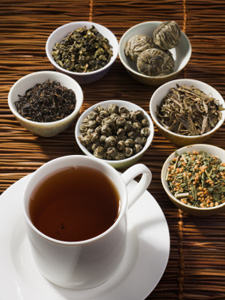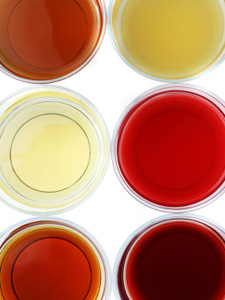Talking Tea


Now that you've learned a bit about properly tasting tea, let's discuss how to effectively talk about tea. The ability to accurately describe the appearance and aroma is critical to sharing your passion for tea. In this lesson we'll discuss some of the more commonly used terms and what they mean. This is best done in person, but we'll do our best to make it easy.
The Leaf
Leafy or Full-Leaf: Used to describe teas that have large, open leaves. Most often these are Oolongs or White Teas like White Peony.
Wiry: Used to describe teas that have long, thin, tightly rolled leaves. An easy example would be a Black Tea like Keemun Concerto.
Needles: Used to describe teas that are either just the leaf bud (not yet opened), or young, opened leaves which have been tightly rolled back into the needle-like shape they had just before opening. Most often these are White Teas like Silver Needle or Green Teas like Gyokuro.
Pearls or Pellets: Used to describe teas that have been rolled into round balls. Most often these are Oolongs like Jasmine Pearl or Green Teas like Gunpowder. NOTE: if the roll is relatively loose, it is sometimes called a "Curl" since it has not been rolled into a perfect sphere.
Tippy: Used to describe teas that have very visible white buds (buds may appear golden in the case of oxidized black teas). Most often these are Whites, Oolongs or Black Teas like Golden Monkey.
Flat or Pan-Fired: Used to describe teas that have been pressed flat (usually by being pan fired). Most often these are Green Teas like Dragonwell. Traditionally this approach is associated with Chinese teas. Pan fired teas tend to have a grassy, slightly roasted aroma and flavor.
Steamed: Used to describe teas that have been steamed. Most often these are Japanese Green teas which can be identified by their dark green color and "shiny" leaves. Their aroma tends to be sweet and briny (like seaweed). A good example is Sencha.
Broken: Used to describe teas where the leaves have been broken into smaller fragments during rolling. Most often these are Black Teas like the base used for Black Cherry. Broken teas tend to be slightly less expensive and deliver a stronger cup when brewed for the same amount of time.
The Liquor
The liquid that results from brewing tea is called the liquor. The potential colors (especially if you include tisanes and flavored teas) run the spectrum of the rainbow. There is no right or wrong here. Get creative and look for terms that you are comfortable with but that are also descriptive. For example, use straw instead of pale yellow; amber instead of orange; jade or emerald instead of green; khaki or olive instead of tan; copper instead of light brown; and mahogany or cognac instead of dark brown.
Flavor and Aroma
The sense of smell and taste are so intricately linked that we'll address them together. One thing to keep in mind is that an unfamiliar word means nothing to a customer. It's useful to know the proper word when talking to a connoisseur, but watch your audience and shift to more general language if necessary.
Astringent: Tea is filled with natural antioxidants, also known as polyphenols. These provide the health benefits in tea and also a good portion of the taste. Polyphenols bind with our saliva and create a dry sensation on the tongue and sides of the mouth. They also provide the brisk, tannic bite that is associated with tea. Whereas bitterness is a center-back of the tongue experience, astringency is sensed more along the sides of the back of your tongue with a physical sensation that is similar to sour. Also important to note: astringency is a physical sensation, whereas bitterness is a flavor - the two can easily be confused, but they are different. While astringency may take some getting used to, at the proper levels it is actually a highly prized characteristic of the finest teas. Cup an excellent first-flush darjeeling for a good experience with astringency.
Vegetal: This is the proper descriptor for what makes a green tea green. Synonyms include herbaceous, crisp, green, and grassy.
Briny: Most often associated with steamed Japanese Green Teas, briny is a good synonym for the seaweed-like taste of these wonderful teas. Briny evokes notes of asparagus, spinach, kelp, and the aroma of the sea. Often, in finer Japanese Green teas like Gyokuro this taste is accompanied by a refreshingly sweet, fruity, finish.
Floral: This term evokes a warm, bright, sweet, pleasant aroma something like perfume. It's a bit of a loose term, but some of the best examples of floral teas are the high-mountain green Oolongs like Ali Shan. Look for the exquisite notes of lilac blossoms with a smooth, buttery finish when cupping these teas.
Roasted or toasted: Especially common among Chinese Green teas is a unique flavor that lies somewhere between roasted chestnuts, walnuts, or almonds, or sometimes even straw/hay. Sometimes called nutty, this flavor is generally created by pan-firing or certain tea drying techniques. Cup a Dragonwell for an example of this flavor.
Umami: If you consider yourself a foodie at heart, this is a term that may already speak to your palate. Umami is the fifth taste component (in addition to salty, sweet, sour and bitter). It is the physical experience of taste; the mouthfeel of the tea. Consider chicken broth: it is salty, certainly, but it also has a rich, savory, buttery taste to it that is far from salty, sweet, sour or bitter. This savory flavor is umami. Search for this richness alongside the bright, fruity notes of a Gyokuro and you'll begin to see what the nuance of flavor and aroma is all about.
Muscatel: What does a tea from Darjeeling taste like? A connoisseur will immediately answer "muscatel". This term is borrowed from the white, muscat grape used for making certain sweet, sparkling wines. Muscatel is brisk, astringent, bright and floral with a dry finish.
Strong: This one is pretty straight forward. It has a lot of taste! Common synonyms include full bodied, bold, rich, robust and heavy.
Earthy: Earthy may overlap at times with strong, but it is also savory, woody, musty and sometimes sweet. Think mushrooms and potting soil. This may be hard to associate with tea, but cup a good Chinese Yunnan and you'll see what we mean.
Malty: The word is borrowed from the rich, caramel sweetness of fermented barley or wheat. While the process is completely different in tea, some strong black teas like the Assam Harmony offer this honeyed, brown sugar richness. Often malty teas are also highly astringent, but not always. Chinese Keemuns are sometimes malty without astringency (smooth).
Smooth: Teas with a full body but without the astringent "bite" often associated with tea may be called smooth, soft, mild, mellow or round. Chinese Keemuns are great examples of a very rich tea that is always smooth. Oolongs may also be regularly characterized as smooth.
Hopefully with these words now in your vocabulary, you'll become a Tea connoisseur in no time!
 teaclass
teaclass
